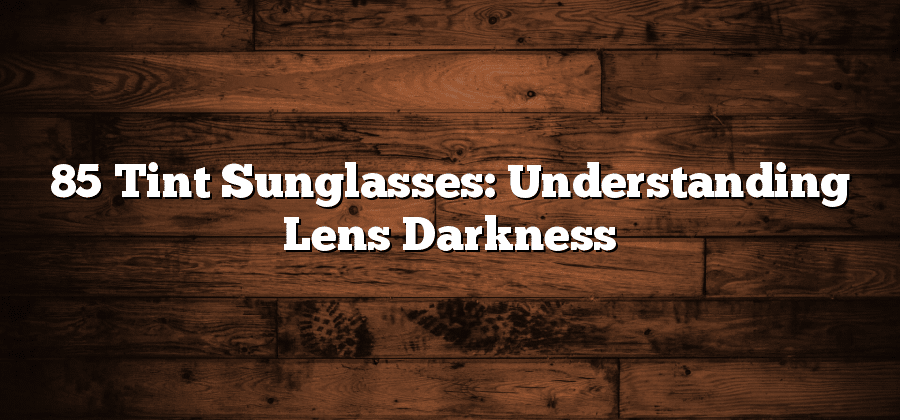Differentiating Lens Tints for Sunglasses
Lens tints play a crucial role in the performance and aesthetics of sunglasses. They are designed to enhance visual clarity, reduce glare, and protect the eyes from harmful UV radiation. Different lens tints are available in the market, each offering unique benefits and suitability for various activities and environments.
One of the most common lens tints is gray, which offers true-color perception and reduces brightness without distorting colors. Gray tints are popular for everyday use, as they provide excellent clarity and are suitable for a wide range of lighting conditions. These tints are particularly effective in preventing eye fatigue in bright sunlight, making them a popular choice for outdoor activities such as driving, hiking, or playing sports.
Another popular lens tint is brown, which enhances contrast and depth perception. Brown tints are known to improve visual acuity, especially in low-light conditions. They are often recommended for activities like fishing, golfing, and skiing, where having clearer vision and better depth perception are essential. Brown tints also tend to reduce blue light, making them suitable for computer use and reducing eye strain caused by prolonged screen time.
The choice of lens tint for sunglasses depends on individual preferences, the intended use of the eyewear, and the specific environmental conditions. It is essential to consider factors such as UV protection, contrast enhancement, color perception, and clarity when selecting the right lens tint for your needs. By understanding the benefits and characteristics of different lens tints, you can make an informed decision and find sunglasses that optimize your visual experience and protect your eyes effectively.
• Gray lens tints offer true-color perception and reduce brightness without distorting colors
• Gray tints are suitable for a wide range of lighting conditions and prevent eye fatigue in bright sunlight
• Popular choice for outdoor activities such as driving, hiking, or playing sports
• Brown lens tints enhance contrast and depth perception
• Recommended for activities like fishing, golfing, and skiing where clearer vision is essential
• Reduce blue light and suitable for computer use to reduce eye strain caused by prolonged screen time
• Individual preferences, intended use of eyewear, and specific environmental conditions should be considered when choosing a lens tint
• Factors to consider include UV protection, contrast enhancement, color perception, and clarity
By understanding the benefits and characteristics of different lens tints you can make an informed decision
The Impact of Lens Darkness on UV Protection
When it comes to selecting sunglasses, one important factor to consider is the darkness of the lens. Many people believe that a darker lens automatically provides better protection against harmful UV rays. While it is true that darker lenses can reduce the amount of visible light that reaches the eyes, the level of UV protection is not solely determined by lens darkness.
In fact, the darkness of the lens does not necessarily indicate the level of UV protection it provides. UV protection is determined by the lens material and the presence of special coatings that block harmful UV rays. These coatings can be applied to lenses of different darkness levels, ensuring adequate protection regardless of lens tint. Therefore, it is crucial to choose sunglasses that offer 100% UV protection, regardless of whether they have a light or dark lens tint.
Factors Influencing Lens Darkness in Sunglasses
Factors influencing lens darkness in sunglasses are diverse and can vary based on various factors. One of the primary factors that determines the darkness of the lenses in sunglasses is the material used. Sunglasses with lenses made from materials like polycarbonate or high-index plastics tend to be naturally darker than those made from regular plastic or glass.
Additionally, the presence of specialized coatings on the lenses can also impact their darkness. Sunglasses with anti-glare or mirror coatings tend to have darker lenses as these coatings help in reducing the amount of light that passes through. Moreover, the manufacturing process and the level of pigment added during the lens production can further influence the darkness. By carefully selecting the materials, coatings, and manufacturing techniques, eyewear designers can create sunglasses with varying degrees of lens darkness, catering to the specific needs and preferences of the wearer.
Understanding the Benefits of 85 Tint Sunglasses
When it comes to choosing sunglasses, understanding the benefits of different lens tints is essential in finding the right pair for your needs. One popular option is 85 tint sunglasses, known for their unique advantages. The 85 tint refers to the specific percentage of light transmission that the lenses allow. With only 15% of light passing through, these sunglasses provide a higher level of darkness, making them suitable for various outdoor activities.
One of the primary benefits of 85 tint sunglasses is their ability to reduce glare. Whether you’re driving, spending a day at the beach, or participating in winter sports, glare can be a significant nuisance and even dangerous in certain situations. The darker lenses help minimize reflections, allowing for better visibility and reducing the strain on your eyes. Additionally, the 85 tint sunglasses are designed to enhance contrast and color perception, making your surroundings appear more vibrant and vivid. This contributes to an improved visual experience, particularly in bright environments where colors may appear washed out without proper filtration. Overall, the benefits of 85 tint sunglasses make them a popular choice among individuals looking to protect their eyes and enhance their visual acuity in various outdoor settings.
Choosing the Right Lens Tint for Your Needs
When it comes to choosing the right lens tint for your needs, it is important to consider various factors that can impact your overall visual experience. One of the main factors to consider is the purpose of your sunglasses. Are you using them for outdoor activities like sports or hiking, or are you simply looking for a stylish accessory? Understanding the intended use of your sunglasses will help narrow down the options and identify the most suitable lens tint for your needs.
Another factor to consider is the environmental conditions you will be exposed to while wearing your sunglasses. Different lens tints have varying levels of light transmission, which can affect your perception of colors and contrast. For example, a darker lens tint may provide better protection against bright sunlight, making it ideal for activities in high-exposure environments. On the other hand, a lighter tint might be more suitable for overcast days or indoor use, as it allows more light to pass through and provides better visibility in lower light conditions. By considering the specific conditions you will be in, you can select a lens tint that optimizes your visual clarity and comfort.



Recent Comments